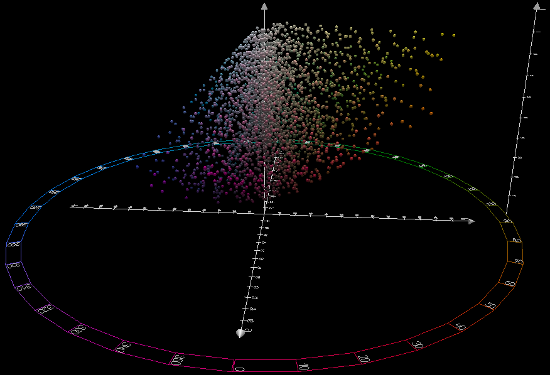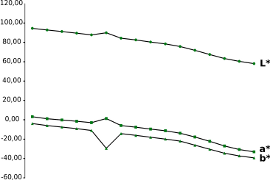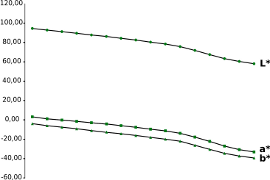Exact Colour Comparisons
How good is the quality of the comparison colour and CMYK-colour values?Fundamental to all comparison calculations of this software is the calibration of the L*a*b*-colour values of the input colour with the stored comparison inventory. The colour distance (ΔE) is calculated for all of the colours of the comparison inventory – the colour with the smallest colour distance wins. This is also true for the CMYK-colour values, for this we measured all of the colour fields of printed atlases.
Why is this process useful and in the case of CMYK-calculations generally better than the usual CMYK-conversion via an ICC-profile?
The CMYK-Conversion via ICC-Profile
The colour space conversion via ICC-profile is built into many computer programs (e.g. Adobe, CS, Corel GS). Since its 1998 inception it has become the virtual standard for the conversion of colour spaces.

ICC-Profile-Colour Conversion in Photoshop
For our Colour Atlas it wouldn’t have been very difficult: We establish an image file from every colour system. Then if, for example, CMYK-colour values are to be made for art print, we convert the file under the provisions of a corresponding ICC-profile (in Photoshop it is called “Euroscale V2“) in the respective colour space. Subsequently we select the CMYK-results through a software out of the resulting image. Our program is also compatible to the ICC-standard so that the users can apply their own profile and all of the profiles of the operating system are also available.
Our tests show: The colour space conversion over ICC-profile does good work at the conversion of pictures for pre-press or the internet. However if you attempt to convert a specific lacquer colour into CMYK as accurately as possible you will notice: The accuracy of the conversion is insufficient in addition to being dependant on the profile used, which is only rarely accurately documented.
This is primarily due to the fact that, as a rule, a high quality ICC-profile relies on ca. 1000 data points (max. 1465 with the FOGRA profiles) for the entire colour space. These data points are possibly reasonably converted – but in the in-between approximation calculations are taking place. On the other hand the CMYK-colour value book “handinhandbuch“ shows that we have measured and delivered ca. 6000 CMYK-colour fields. The accuracy of the likewise measured database “DCS BOOK Professional“ from grafipress is even higher. It contains over 65000 colour fields. It should be clear that the accuracy of the colour matching of a colour in our process, in contrast to the ICC-profile supported colour value conversion, musst be higher.
Although there are numerous options available for the proximity calculations (the so called “rendering intents“, “colorimetric“, “absolute/relative“, “saturation“, ...), they remain proximity calculations that are only imprecise matches to the original.
...and the Colour Distance Minimasation within the CMYK-Colour Fields
The DIGITAL COLOUR ATLAS is based on a complete spectral photometric measurement of all supported colour atlases and colour fans (all in all ca. 300000 measurements). These measurements represent the largest part of the work on the software, and now they are available as CIELAB-colour value tabels in the background (in the directory “colour systems“). Every colour system is equivalent to a measurement value data set.
If the nearest colour to an input colour is being searched for in a colour system, a colour distance minimisation is performed.
- Initially the colour distance (ΔE) of the input colour is determined to every colour in the comparison colour system.
- Then the colour is selected from the comparison system that displays the smallest ΔE-value.
- The resulting colour is displayed in the program; the ΔE-value delivers a statement about the quality of the match.

The screenshot shows all colour tones of the HKS raster fan in the CIELAB-colour space. The delta-E-value designates the distance of two colours in this spatial representation. The smaller the distance, the more similar the colour.
The calculation takes place in the complete data base, in the comparison colour fan every colour is actually compared with the original. The result of the calculation almost always agrees with the eye and perception of a practiced colour matching professional.
Addtionally the DIGITAL COLOUR ATLAS can conduct further interpolation calculations in order to raise the accuracy.
The program does not calculate with the simple spatial distance formula (ΔE after Hunter), rather with an improvement (ΔE2000), which takes the differences in input colour tone more into account than differences in lightness and saturation, just as our eye does.
You can see the exact formulas in our small formulary.
Revisions of the CMYK-Measurement Data
All CMYK-data series are “freed“ from so called outliers before undergoing detailed revisions.
Outliers stem from print inaccuracies, dust particles or measurement mistakes. In the framework of revision L*a*b*-measurement values were defined as outliers if their L*, a* or b* deviated from the mean value of their neighboring value by more than two units.

Outliers

Unusual values were later corrected by hand.
By using this complex revision process the quality of the CMYK-data compared to the previous version was noticeably improved.